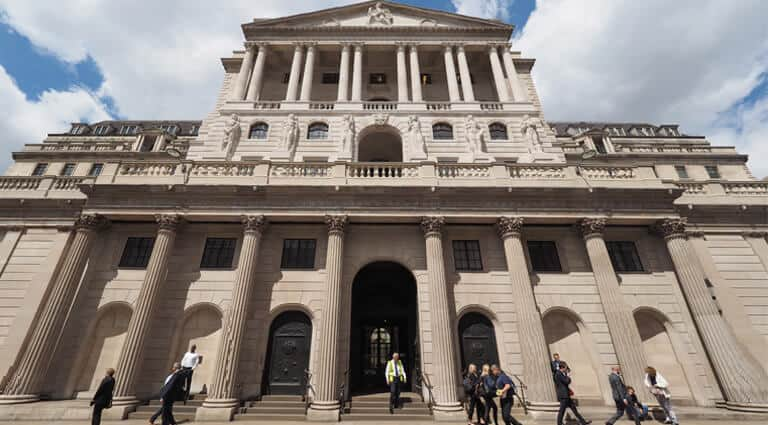The Bank of England is one of Britain’s most historic and famous financial institutions. Founded in 1694 as the English government’s bank, it is the eighth oldest bank in the world today and has become a major tourist attraction in its own right.
As one of Britain’s most important banks, it is authorised to issue banknotes in England and Wales, and regulates the issuing of banknotes by commercial banks in Northern Ireland and Scotland. Its Monetary Policy Committee is responsible for managing Britain’s financial policies.

© Claudio Divizia / Shutterstock.com
Gold vaults
The Bank of England’s headquarters has been at Threadneedle Street, in London’s main financial district, since 1734. The gold vaults hold around 400,000 bars of gold, with a total value of more than £100 billion!
It hasn’t offered consumer banking services for many years, although it does carry out some public-facing services, such as exchanging old banknotes.
Visiting a bank may seem a strange destination for visitors – but on the contrary, it provides a fascinating day out, as it is so much more than just a financial centre. The Bank of England’s museum is a treasure trove of factual and fun exhibits for people of all ages to enjoy.
The imposing frontage of the building dominates the City of London, with its museum, off Bartholomew Lane, being something of a hidden treasure.
The museum’s attractions
Opened by Queen Elizabeth II in November 1988, the museum traces the bank’s history from when it was first established 325 years ago, to its important role today.
Visitors can stroll around a reconstruction of an 18th-century banking hall, designed by Sir John Soane, the leading English architect of the era. There were no windows in those days for extra security, so the bank was a dark and dingy place. Soane had designed a domed roof to help let in as much light as possible.
You will be invited to learn more about how the bank moved to Threadneedle Street in 1734 and expanded over the years, until it filled the whole of its current site by 1833. It functioned largely unchanged until after the Great War, when architect Sir Herbert Baker designed and rebuilt it.
Having worked in New Delhi earlier, he was influenced by the architecture in India and the façade’s grand imperial style is tribute to this. The current building was finally completed just before World War II broke out in 1939.
Prior to the opening of the Bank of England, banking was run largely by goldsmiths, who loaned money to the Crown and to merchants. Goldsmith notes preceded modern banknotes. Visitors can walk through three rooms detailing the bank’s early history and look at fascinating artefacts, such as parts of old banknotes from 1694.
Famous customers
Among the exhibits are sections detailing some of the bank’s famous customers; including the great explorer, sea captain and military leader, Admiral Horatio Nelson; the composer George Frideric Handel; and American president George Washington, who held stock at the bank.
Although the bank has never been robbed in 300 years, it was protected at night by the military (known as the Bank Guard) after the Gordon Riots of 1780, when people tried to enter the building from an adjacent church.
As a result, the church was knocked down, although the graveyard remained. It has since become a garden, which is now within the bank’s walls and is open to the public at various times throughout the year.
As well as the historic exhibits, the museum emphasises the bank’s important role today. Visitors can watch interactive videos to see how it carries out its day-to-day duties. There are attractions for children too, including a giant hot air balloon, which serves the dual purpose of teaching kids about monetary inflation.
There are story-telling sessions and also informative talks for adults on topics such as the building’s history and the economy.
Anniversary celebrations
The bank has some special celebrations taking place this year in honour of its 325th anniversary. To highlight the bank’s key moments and unique history, the exhibition features 325 exhibits for 325 years.
The focus is firmly on the place and people, rather than the bank’s technical side, giving it a human feel. Themes include life at the bank, with some of the temporary exhibits later being incorporated into the bank’s permanent exhibitions.
Audience research is being carried out during the anniversary celebration to see which of the exhibits grab the public’s attention.
Glimpse of history
Each section provides a glimpse into history and focuses on the bank’s work at various periods in time. Some of the historic objects have never been exhibited before. One of the key focal points is a unique new artwork commission, which will be permanently on display.
The exhibition is aimed at showing more diverse aspects of the bank’s history, introducing some of the key characters who have figured over the years. There is particular emphasis on the role women have played at the bank, in what was an essentially male-dominated field when it opened 325 years ago. Initially, women were only investors, but later on, they became staff members too.
While planning the exhibition, the organisers have unearthed some lesser-known stories, and plans are in the pipeline to fill in any gaps in the bank’s history with future exhibitions in the museum.
If you’re planning a trip to London to visit famous attractions such as the Bank of England, a minibus from H&H Van Hire is the ideal way to travel. Contact us today for details of our modern nine, 14 and 17-seater minibuses.


